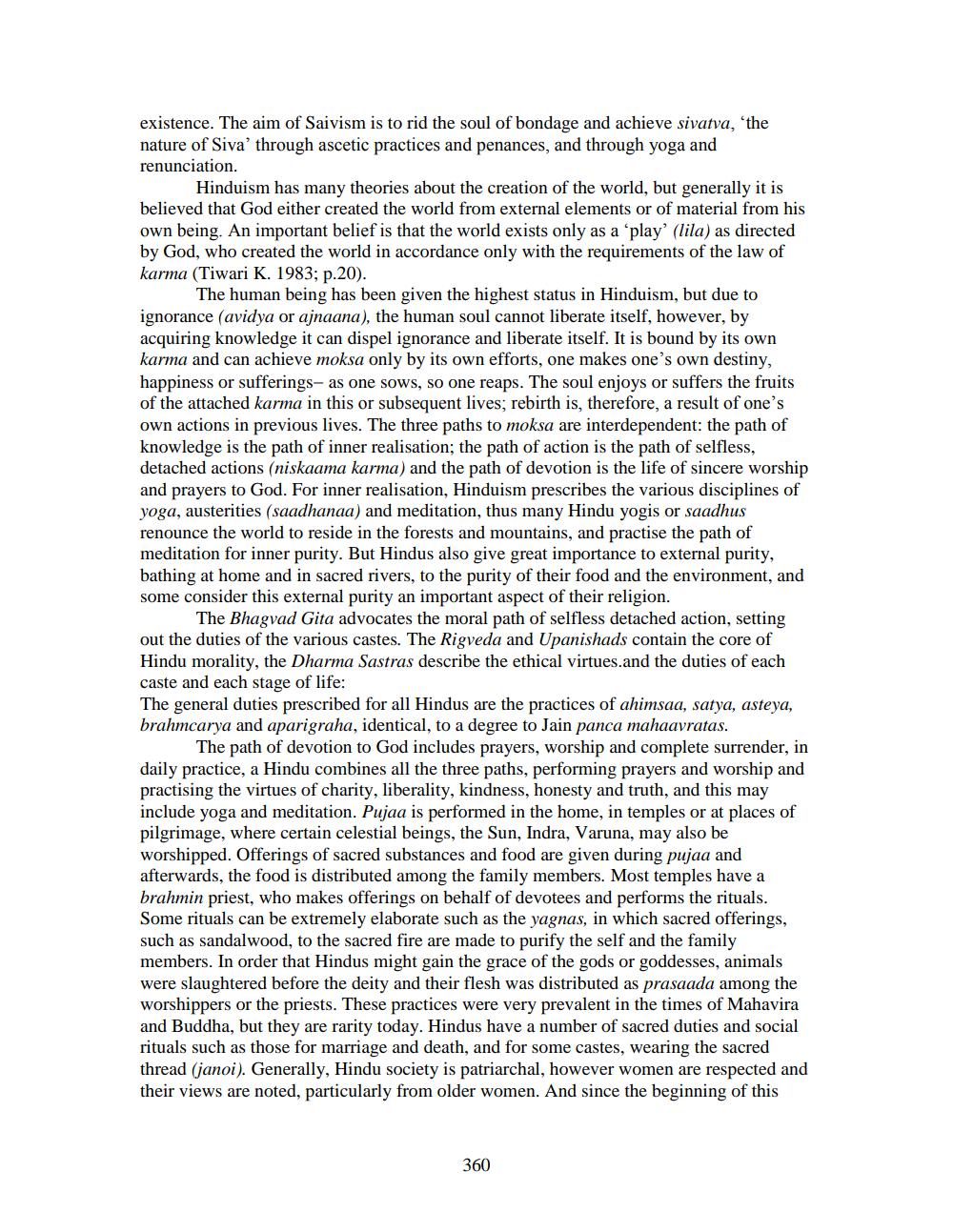________________
existence. The aim of Saivism is to rid the soul of bondage and achieve sivatva, 'the nature of Siva' through ascetic practices and penances, and through yoga and
renunciation.
Hinduism has many theories about the creation of the world, but generally it is believed that God either created the world from external elements or of material from his own being. An important belief is that the world exists only as a 'play' (lila) as directed by God, who created the world in accordance only with the requirements of the law of karma (Tiwari K. 1983; p.20).
The human being has been given the highest status in Hinduism, but due to ignorance (avidya or ajnaana), the human soul cannot liberate itself, however, by acquiring knowledge it can dispel ignorance and liberate itself. It is bound by its own karma and can achieve moksa only by its own efforts, one makes one's own destiny, happiness or sufferings- as one sows, so one reaps. The soul enjoys or suffers the fruits of the attached karma in this or subsequent lives; rebirth is, therefore, a result of one's own actions in previous lives. The three paths to moksa are interdependent: the path of knowledge is the path of inner realisation; the path of action is the path of selfless, detached actions (niskaama karma) and the path of devotion is the life of sincere worship and prayers to God. For inner realisation, Hinduism prescribes the various disciplines of yoga, austerities (saadhanaa) and meditation, thus many Hindu yogis or saadhus renounce the world to reside in the forests and mountains, and practise the path of meditation for inner purity. But Hindus also give great importance to external purity. bathing at home and in sacred rivers, to the purity of their food and the environment, and some consider this external purity an important aspect of their religion.
The Bhagvad Gita advocates the moral path of selfless detached action, setting out the duties of the various castes. The Rigveda and Upanishads contain the core of Hindu morality, the Dharma Sastras describe the ethical virtues.and the duties of each caste and each stage of life:
The general duties prescribed for all Hindus are the practices of ahimsaa, satya, asteya, brahmcarya and aparigraha, identical, to a degree to Jain panca mahaavratas.
The path of devotion to God includes prayers, worship and complete surrender, in daily practice, a Hindu combines all the three paths, performing prayers and worship and practising the virtues of charity, liberality, kindness, honesty and truth, and this may include yoga and meditation. Pujaa is performed in the home, in temples or at places of pilgrimage, where certain celestial beings, the Sun, Indra, Varuna, may also be worshipped. Offerings of sacred substances and food are given during pujaa and afterwards, the food is distributed among the family members. Most temples have a brahmin priest, who makes offerings on behalf of devotees and performs the rituals. Some rituals can be extremely elaborate such as the yagnas, in which sacred offerings, such as sandalwood, to the sacred fire are made to purify the self and the family members. In order that Hindus might gain the grace of the gods or goddesses, animals were slaughtered before the deity and their flesh was distributed as prasaada among the worshippers or the priests. These practices were very prevalent in the times of Mahavira and Buddha, but they are rarity today. Hindus have a number of sacred duties and social rituals such as those for marriage and death, and for some castes, wearing the sacred thread (janoi). Generally, Hindu society is patriarchal, however women are respected and their views are noted, particularly from older women. And since the beginning of this
360




